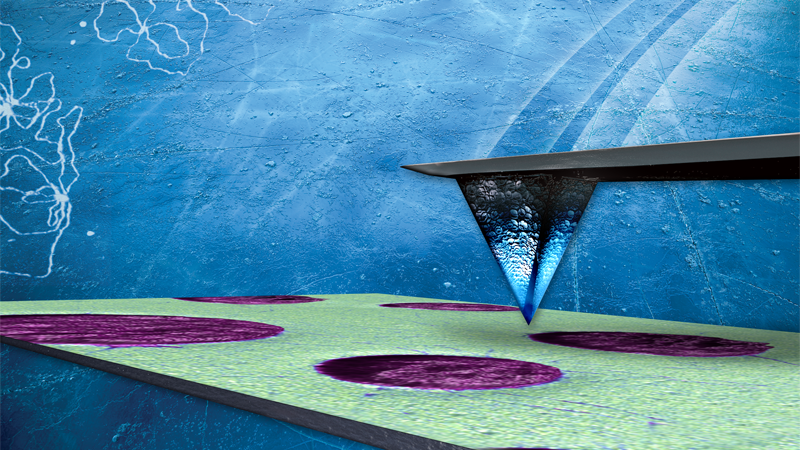PeakForce Quantitative Nanomechanics (QNM)
Utilizing PeakForce Tapping® technology, PeakForce QNM® maps and distinguishes between nanomechanical properties—including modulus, adhesion, dissipation, and deformation—with up to atomic resolution in topography as well as in the property channels. It is non-destructive to both tip and sample since it directly controls the peak normal force and minimizes the lateral force on the probe. Since force distance data is analyzed directly, there is no ambiguity regarding the source of image contrast, as often occurs in other techniques. The quantitative data produced can help researchers answer the critical question of what materials they are seeing in their topographic images.
The latest generation of PeakForce QNM comes with unique precalibrated PeakForce Tapping probes and an integrated workflow that make the acquisition of calibrated modulus data routine. Not even a reference sample is needed to obtain quantitative data.
PeakForce QNM provides:
- Highest resolution mapping of nanomechanical properties
- High-speed, most quantitative nanomechanical mapping
- Widest operating range for samples, from extremely soft materials (~1 kPa) to hard metals (100 GPa)
PeakForce QNM enables:
- Submolecular resolution mapping of mechanical, chemical and biological interactions
- High-speed, quantitative mechanical property and adhesion mapping of live cells
- Easiest to use, making every user an AFM expert
Peak-Force QMN is undoubtedly a robust tool that will serve the community well in the years to come and open new area of research through its integrative imaging and mechanical measurements. My experience of Peak-Force QMN is certainly inspiring for me and my students. The capability to image and acquire mechanical information simultaneously will increase the throughput of samples and increase data correlation whilst being able to handle complex samples. We may just be experiencing a new evolution in AFM since the arrival of Force Volume.
Dr. Laurent Bozec, University College London
With the unique capabilities of PeakForce QNM and the versatile operation modes on our BioScope AFM, we are ready to extend our micro- and nano-robotic manipulation research of biological samples with ultrahigh resolution.
Dr. Zhang Li, Chinese University of Hong Kong
The new PeakForce Quantitative Nanomechanics (QNM) is by far the most powerful and quantitative high-resolution AFM technique to probe quantitative chemical and mechanical properties of living biological samples with an acquisition speed comparable to tapping mode.
Dr. Suzana Šegota, Ruđer Bošković Institute, Croatia
With the combined application of PeakForce QNM and PeakForce TUNA we were uniquely able to determine the nanostructure and ionic conductivity distribution on humidity sensitive ionomers with unprecedented quality and resolution. For us, the versatility and flexibility of the MultiMode 8 AFM with these modes opens the path for numerous explorations of materials for electrochemical energy applications.
Dr. Renate Hiesgen, University of Applied Sciences Esslingen, Germany


